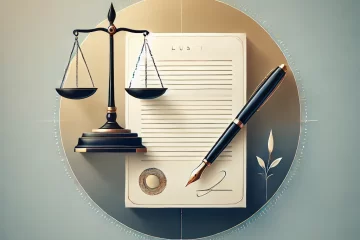![]()
Introduction:
The Oxford Dictionary defines drafting as “preparation of a preliminary version (of a document)”. Drafting is an art in the legal field and the advocate is the artist responsible for creating this art. It involves the presentation of all the relevant issues, statements, and information. Drafting is the synthesis of law and fact in a language form.[1] In its wide circumference of meaning, it includes the drafting of several legal documents such as wills, gift deeds, or contracts.
The principles of drafting are not very different when being done by a lawyer but they are essentially required to be followed in this particular field than others for an effective and impactful outcome of the drafting skills of any lawyer. While there exist differences in several rules in congruence with the different fields that they are subjected to, some principles are generally used in all fields and professions and the differences are usually more intricate and found in the finer details.
The person who makes the draft or writes the draft is called a draftsman.[2]
It is important for any individual trying to set foot in the legal world to master this particular art called drafting.
Some of the general principles of drafting that a person should keep in mind are the following.
Plain Language
While the law has been conflicted with a tendency to opt for complicated and convoluted language, the Plain English Movement has been successful in bringing about a reform where the language of the lawyer or rather the law has been simplified so, that a common man can comprehend the contents of it. With this perspective in mind, it is of utmost importance to use plain language that is within the ambit of understanding of a common and reasonable man. This does not imply that legal terms are to be done away with but rather that redundant jargons and complicated sentences are not to be used.
The language used while drafting should be lucid, clear, and accurate i.e., in plain language.
The draft should be void of ambiguities or vagueness and if such elements are present, they should be done to serve the purpose or for the benefit of the lawyer. As such, the language used by the draftsman should be along the lines of plain, simple, lucid, and accurate.[3]
Conciseness
A good draft is concise. A draft is like a harmony or rather a synthesis of the facts and the law. For this reason, it should be concise and clear. It should include only the relevant and essential facts and information. It would be inappropriate to have a draft include unnecessary and unimportant information. Since a draft generally includes all the information and questions of law, it is a general understanding that the language of the draft while being simple, accurate, and lucid should also be to the point, short, and concise. This makes it easier for the reader to comprehend and to read the draft effectively. Circumlocution should be avoided as far as possible as it opposes the principles of plain language as well as that of being concise. Short sentences should be preferred over long ones.
Clarity
There is a saying that ‘if one has something to say, one should say it clearly or should not say it at all’. Another principle to be kept in mind while drafting is to have clarity not only in the words and sentences but also in the flow of ideas and the logical sequence or structure of the draft. It is very important to have clarity as any vagueness or ambiguity in a draft would ruin it. Brevity is the choice of words is very important. While it has been stated to use simple language, it should be noted that words should be chosen carefully. If there is an opportunity to use a simpler word, the opportunity should not be wasted. The person who drafts should use simple words in order to enable the reader to read without any strain or stress. For instance, if the sentence is ‘A met with an accident’, it should not be stated in a complicated manner such as ‘ A was unfortunate enough to have met with the tragedy of an accident’. The greatest quality of a draftsman is to be concise and clear in the language he uses.
Logical Approach
The draft should be devoid of any grammatical mistake and the structure should follow logically. The text should be free of spelling errors. Such errors reflect badly on the draftsman. Errors such as spelling mistakes or incorrect use of grammar should be avoided at all costs as the very basic pre-requisite skill demanded of any draftsman is to have a command over the language. The content of the draft should be divided and paragraphs should be used as and when required. This allows the reader to comprehend the contents of the draft clearly and ensures that they can follow the flow of the text without being lost or confused. It also gives them time to digest the information provided by the text. The text should also adhere to the chronological order of the facts if that may be the case. For instance, if the facts include information that A went to the bank and then met with an accident and these be the material facts, then these facts should be written in chronological order and should not be mixed up. It is also preferred to use active voice rather than passive voice.
Mind Mapping
The draftsman in order to avoid the mistakes mentioned above should plan his draft before actually writing it. There should be a clear map listing the things that he needs to include or exclude and where which content would fall. It should be like a skeleton of the actual draft or a design of the actual draft. Mind mapping is a useful tool for any person who has to draft documents as it clears the mental confusion that the draftsman may have. Mind mapping allows the draftsman to have a clear idea and plan. This ensures that nothing is misplaced or placed at random instances and that no fact is forgotten as the draftsman can always have a look at the rough synopsis of the draft to see or check all that he has already done or missed. This rule was also proclaimed by Piesse and Gilchrist. They also propounded the rule of not admitting omitting or admitting any fact or information at random and using legal language that is precise and clear.
Politeness
The draftsman should be polite and amicable while writing the content of the draft. Politeness has a far-reaching impact.
Keep it Simple Stupid (KISS)
The draftsman should also put himself in the shoes of the reader while proof-reading his or her draft. It is important to do so as a writer, one may not be able to find difficulties in the text written but as a reader, they will be able to comprehend and come across the difficulties that a reader may face while going through the text. While writing, the writer has a different perspective as compared to the reader. The draftsman should be considerate of the reader.
Conclusion
Drafting is indeed an art but it can be mastered easily if one adheres to the general principles mentioned above. They apply to all kinds of documents and across different fields. They are not limited to law alone but they do benefit a draftsman who is a lawyer more. These principles outline the understanding that a successful draft is one that is written, concisely, accurately in plain language with a logical structure to support it.
Drafting is an art that unlike other art does not demand of an artist to be novel, ambiguous, or complex. It demands the author or rather the artist to be simple and clear with words and ideas, to adhere to rules and not set out to find novel paths, and simply to be economical and have brevity in their language. Unlike an artist whose art is to not be considerate of the viewer, a draftsman is a sort of artist that strives purely to appease the reader, its audience and this audience is very singular in its likes and dislikes. Drafting is an art that is a confluence of law and language most sensibly and formally.
References:
[1] Legal Drafting Rules And Tips – LawOrdo, https://www.lawordo.com/legal-drafting-rules-and-tips/
[2] THE CONCEPT OF DRAFTING & ITS GENERAL PRINCIPLES, https://www.lawaudience.com/the-concept-of-drafting-its-general-principles/
[3] General drafting principles – Weagree, https://weagree.com/drafting-principles/1-general-drafting-principles/



0 Comments